4-way Switch Wiring Diagrams
by: Dale Cox
Check permit requirements before beginning electrical work.
How to read these diagrams.
The wiring diagrams on this page make use of one or more 4-way switches located between two 3-way switches to control lights from three or more points. For 4-way multiple light diagrams see these, for 3-way switch diagrams see these. On this page are several diagrams that can be used to map 4-way and 3-way lighting circuits depending on the location of the source in relation to the switches and lights. Also included are a 4-way dimmer switch diagram and an arrangement to control lights from four different locations. Also find 4-way switch troubleshooting tips here, and information on how these circuits work at this link.
Wiring a 4-way Switch with Light at the End
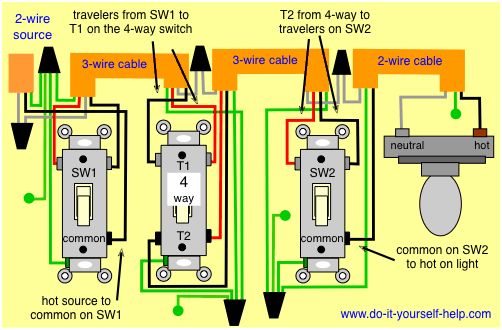
In this basic 4-way light circuit, 3-wire cable runs between all the switches and 2-wire cable runs from the last one to the light. The electrical source is at the first 3-way switch and the hot wire connects to the common there. The circuit neutral is spliced at each box through to the light fixture using the white wire. The black and red wires running between the boxes are connected to the travelers on each switch. The common terminal on the 3-way at the end of the circuit connects to the black wire running to the hot terminal on the light.
Take note that the traveler wires from SW1 are connected to the T1 pair on the 4-way switch and the travelers going to SW2 are connected to the T2 pair. Each pair of traveler terminals from the 4-way must be connected to only one of the 3-ways. Don't mix up the pairs or the circuit will not work properly.
4-way Switch Wiring with Light First
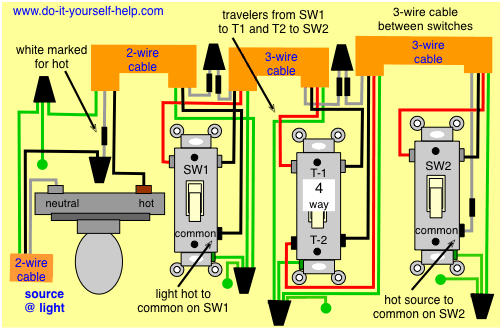
This diagram illustrates wiring for a 4-way circuit with the electrical source at the light fixture and the switches coming after. Two-wire cable is run from the light to SW1 and from there, 3-wire cable runs between all the switches. The source neutral wire is connected directly to the light fixture and the hot is spliced to the white cable wire running to SW1. At SW1 it's spliced to the white wire running to the 4-way box where it's spliced to the white wire running to common terminal on SW2. The white wire is marked with black at each splice to identify it as hot.
At SW1, the common terminal is connected to the black wire running to the light fixture hot terminal. The black and red wires running between the switches are used to connect the travelers on each one.
Take note that the traveler wires from SW1 are connected to the T1 pair on the 4-way and the travelers going to SW2 are connected to the T2 pair. Each pair of traveler terminals on the 4-way must be connected to only one 3-way. Don't mix up the pairs or the circuit will not work properly.
4-way Diagram Light Between Switches
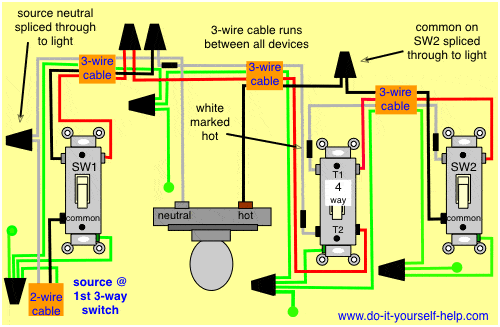
Here the circuit source is at the first 3-way and the light fixture is between there and the other switches. Three-wire cable runs between the light and all the switches in the circuit.
The source hot wire is connected directly to the common on SW1 and the neutral wire is spliced through directly to the light fixture neutral terminal. The black and red wires running from SW1 are used as travelers and at the light fixture box they are spliced to the red and white wires running to T2 on the 4-way. The white wire is marked with black at both ends to identify it as hot. The black wire from the hot terminal on the light runs to the 4-way box where it is spliced to the black wire running to the common on SW2. The red and white are used as travelers between T1 on the 4-way and the travelers on SW2. Again, the white is marked black at each end to mark it as hot.
4-way Wiring Source and Light Middle
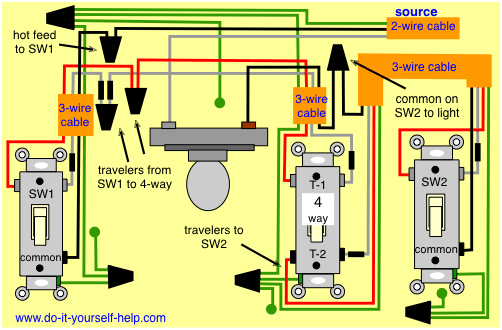
This wiring shows the light fixture and the electrical source together in the same box located between the switches. Three-wire cable runs throughout the circuit and the hot source is spliced to the black wire running to the common terminal on SW1. The neutral is connected directly to the light fixture. The 4-way comes right after the light fixture but before the second 3-way, making it fall between the two 3-ways as needed. It could also be installed on the other side of the light and the effect would be the same.
The red and white wires from SW1 are used as travelers, at the light box they are spliced to the red and white running to T1 on the 4-way. The white wire is marked black on both ends to label it as hot. The black wire from the light to the 4-way box is spliced to the black wire running to the common on SW2. The red and white traveler wires from T2 run to SW2 and again, the white is marked black on the ends.
4-way Wiring with Four Switches
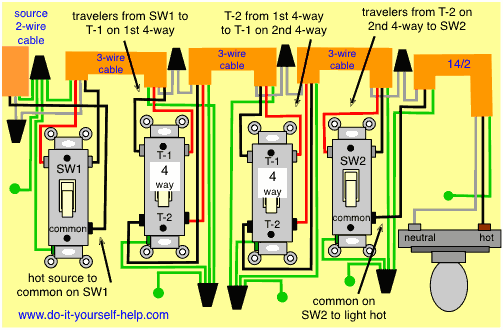
Here two 4-way and two 3-way switches are used to control lights from four different locations. The two 4-ways are located between the two 3-ways and the traveler wires run from SW1 to T1 on the first 4-way. T2 from that switch is wired to T1 on the second 4way and T2 from there connects to the travelers on SW2.
The source is at SW1 and the hot wire is connected to the common terminal. Three-wire cable runs between all switches and 2-wire cable runs from the last one to the light fixture. The black and red wires running between all devices are used as travelers in this arrangement. The white neutral wire from the source is spliced at each box to run it through to the neutral on the light fixture. The black wire from SW2 is used to connect the common terminal to the hot on the light fixture.
4-way Dimmer Switch Wiring Diagram
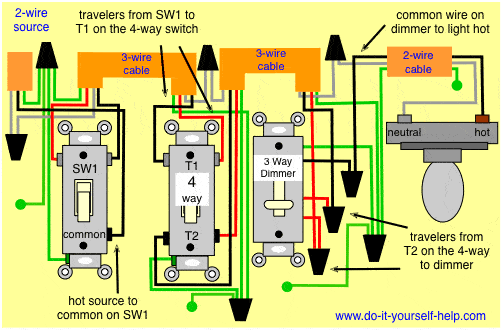
This is the wiring for a dimmer in a 4-way circuit. Three-wire cable runs between all the switches and 2-wire cable runs to the light. To make this circuit work, a 3-way dimmer can be used in place of one, or both of the standard 3-way switches. In fact, a dimmer can be used this way in place of any of the 3-ways on this page.
A 3-way dimmer has 4 stranded wires: one common, two travelers, and a ground. These stranded wires are spliced to the cable wires from the house circuit. On a dimmer like this, the common wire is usually black and the travelers red. In any case, the traveler wires will be colored the same to distinguish them from the common.
In this diagram the source is at SW1 and the hot is connected to the common terminal there. The source neutral is spliced at each box to run it directly through to the neutral on the light fixture. The black and red wires running between switches are used as travelers in this circuit. The black wire running to the light is used to connect the common from the dimmer to the hot terminal on the light.
Troubleshooting 4-way Switch Circuits
The most likely cause of circuit failure is an error in the wiring arrangement. Verify the circuit is wired correctly using the following guidelines.
A 4-way switch must be wired between two 3-way switches as shown in the diagrams on this page. A 4-way switch has five terminals: one ground and 4 circuit terminals divided into two matching pairs called travelers. Each pair of traveler terminals should be wired to the traveler wires from one of the 3-ways in the circuit. The travelers from one 3-way can be wired to either terminal in a pair on a 4-way but don't mix up the pairs or the circuit won't work properly.
In order for a 4-way circuit to work, the 3-ways must be wired properly at the beginning and end of the path. So be sure that the common terminal on one of the 3-ways is wired to the hot source, and the common on the second 3-way is wired to the the hot terminal on the light or fan.
Check to be sure the traveler wires only connect between the traveler terminals on all the switches. A 4-way switch will only be connected to traveler wires, never to a hot source or load wire and never to a neutral wire. Also, confirm that each pair of travelers on a 4-way are only connected to one 3-way per pair. Check that the neutral from the source is only connected to the neutral terminal at the load. A neutral wire will never be connected to standard 3-way and 4-way switches, although some smart switches and timers may make use of a neutral wire to operate the device. If you believe your circuit is wired correctly and the lights still don't work, one or more of the switches may be defective. You can test the them using the procedure described below.
Testing Switches
If you have existing switches that stop working, they may be worn out or the terminal screws may have loosened over time. With the power off and the device removed from the outlet box, check that all connections are still tight using a screwdriver. If the connections are made with clamps instead of screws, tug firmly on the wires to be sure they are all still tight.
If you have an old or new switch you believe was wired correctly and the circuit still doesn't work, the switch may be defective. In these cases, you can test the internal functionality with a simple procedure. Turn off the power and remove the switch from the circuit by disconnecting the wires. Use a continuity tester or multimeter on the Ohms setting to determine if it's conducting electricity properly.
To test a 3-way switch, connect one meter probe to the common terminal and the other to one of the travelers. Flip the switch toggle one way and then the other. If the meter shows continuity with the toggle in one direction and not the other, move the probe from that traveler terminal to the other one and test again. If you find the second traveler shows continuity with the toggle in one direction and not the other, the switch is probably functioning properly. If, however, you don't find any continuity or constant continuity no matter where the probe is or how you flip the toggle, the switch is likely defective and should be replaced.
To test a 4-way switch, connect one probe to one traveler terminal in a pair and the other probe to one traveler terminal in the other pair. Flip the toggle and check that you find continuity in one direction but not the other. Move one probe to the other terminal in its pair and test again for the same results. Move the second probe to the other terminal in its pair and test both arrangements again. If you find alternating continuity when you flip the toggle in all possible arrangements, your switch is probably working properly. If you find no continuity or constant continuity in any of the possible arrangements when you flip the toggle, the switch is likely defective. One note about this procedure, if you are dealing with a smart electronic switch or timer, the internal circuitry can not be tested in this way.
 Wiring 3-Way Switches
Wiring 3-Way Switches Wiring Light Switches
Wiring Light Switches 4-Way Wiring for Multiple Lights
4-Way Wiring for Multiple Lights Wiring for Ceiling Fan Switches
Wiring for Ceiling Fan Switches Wiring Circuit Breakers
Wiring Circuit Breakers